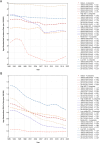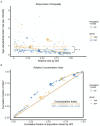Global burden of pediatric urolithiasis: A trend and health inequalities analysis from 1990 to 2021
- PMID: 40214799
- PMCID: PMC11991946
- DOI: 10.1007/s00431-025-06134-4
Global burden of pediatric urolithiasis: A trend and health inequalities analysis from 1990 to 2021
Abstract
This research seeks to evaluate the worldwide burden, health inequities, and projected trends of pediatric urolithiasis from 1990 through 2021. We calculated age-standardized incidence rates, prevalence rates, and disability-adjusted life years rates from the 2021 Global Burden of Disease database. Joinpoint regression was applied for time-trend analysis. Health disparities were measured by using Spearman correlation analysis, Relative Concentration Index, and Slope Index of Inequality. Bayesian Age-Period-Cohort models predicted future global age-standardized incidence rates trends. Global age-standardized incidence rates declined from 79 (95% confidence interval [CI], 38-132) cases per 100,000 population in 1990 to 75 (95% CI, 37-124) cases per 100,000 in 2021, although the total number of cases rose. Age-standardized incidence rates decrease sharper in high Socio-Demographic Index regions. Geographical differences reveal significant health disparities, with age-standardized disability-adjusted life years rates higher in countries with a low Socio-Demographic Index. Bayesian Age-Period-Cohort models forecast a slight rise in global age-standardized incidence rates.
Conclusions: While global age-standardized incidence rates for pediatric urolithiasis have shown a downward trend, the increasing number of cases and persistent age-standardized disability-adjusted life years rates burden in low-SDI regions underscore pressing concerns. Efforts focused on prevention, early detection, and equitable access to healthcare are critical to bridging these gaps and improving global outcomes.
What is known: • Pediatric urolithiasis imposes a significant global burden, with higher recurrence rates and long-term impacts on kidney function. • The incidence of urolithiasis in children varies greatly in different countries or regions around the world.
What is new: • This study provides the comprehensive analysis of global trends and health inequalities in pediatric urolithiasis from 1990 to 2021 using GBD 2021 data. • Persistent inequalities remain, with disadvantaged regions bearing heavier burdens despite global improvements.
Keywords: Age-standardized rate; Disability adjusted life-years; Global burden of disease; Incidence; Prevalence; Urolithiasis.
© 2025. The Author(s).
Conflict of interest statement
Declarations. Ethics approval: This study did not involve patient personal information. The data usage complies with the Institute for Health Metrics and Evaluation (“IHME”) Free-of-Charge Non-commercial User Agreement, and no additional ethical approval was required. Consent to participate: Not applicable. Consent for publication: Not applicable. Competing interests: The authors declare no competing interests.
Figures




References
-
- Sorokin I, Mamoulakis C, Miyazawa K, Rodgers A, Talati J, Lotan Y (2017) Epidemiology of stone disease across the world. World J Urol 35(9):1301–1320. 10.1007/s00345-017-2008-6 - PubMed
MeSH terms
LinkOut - more resources
Full Text Sources
Medical

